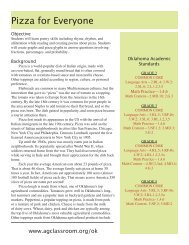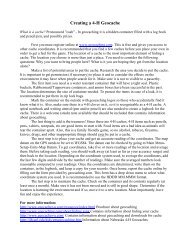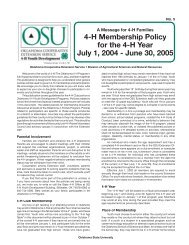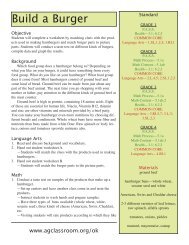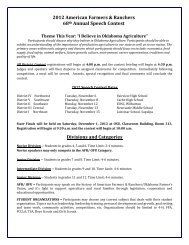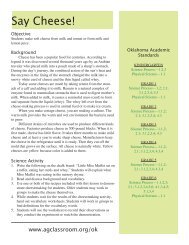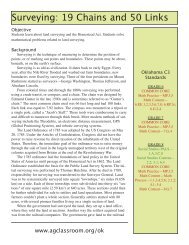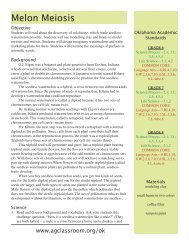Create successful ePaper yourself
Turn your PDF publications into a flip-book with our unique Google optimized e-Paper software.
<strong>Read</strong> <strong>Before</strong> <strong>You</strong> <strong>Eat</strong><br />
Skills: Health, Language Arts, Math<br />
Objective: Students learn to understand the nutrition label on different<br />
foods and be prepared to make heathlier food choices.<br />
Background<br />
Food labels tell us what is in the food we are eating. A law passed in<br />
1993 says manufacturers of processed foods have to list all the ingredients<br />
used in the food. This is very important for people who have food allergies<br />
and for those who have food restrictions for religious reasons, but we should<br />
all be aware of what is in the food we eat.<br />
The first ingredient on the list will be the main ingredient. On a jar of<br />
jelly, the first ingredient listed may be fructose or sucrose. Those are two<br />
kinds of sugar. If they are the first on the list, you know there is more sugar<br />
in the jelly than anything else. The next ingredient on the list will probably<br />
be some kind of fruit. That means after sugar, there is more fruit than anything<br />
else.<br />
Another law says food manufacturers have to show how much of the US<br />
Food and Drug Administration’s recommended daily allowances (RDA) are<br />
in one serving of food. Recommended daily allowances are what nutrition<br />
experts say we need to eat every day to be healthy<br />
Language Arts<br />
1. <strong>Read</strong> and discuss background and the <strong>Read</strong>ing Page included in this lesson.<br />
Lead a discussion based on the questions provided with the <strong>Read</strong>ing<br />
Page.<br />
2. Provide food packaging for students to handle and examine. Discuss what<br />
makes some packages more appealing than others.<br />
2. Bring in an assortment of print advertisements or taped commercials.<br />
Discuss the many reasons students would or would not be interested in<br />
the products they see advertised. Discuss the eye-catching colors, special<br />
offers, the models or actors used, etc. Ask students if they are swayed to<br />
buy the product more by the packaging or by what their families or peers<br />
like.<br />
P.A.S.S.<br />
GRADE 4<br />
Health/Safety—2.4, 6; 3.1;<br />
4.1,3; 6.2<br />
<strong>Read</strong>ing—3.1ab,2ab,4a<br />
Visual Literacy—1<br />
Math Process—1.2,3,5;<br />
4.4<br />
Math Content—1.1,2b;<br />
3.2ac; 5.1b<br />
GRADE 5<br />
Health/Safety—7.1<br />
<strong>Read</strong>ing—3.1abd,2ab,3bc<br />
Visual Literacy—1<br />
Math Process—1.2,3,5;<br />
4.4<br />
Math Process—3.2b; 5.1a<br />
Materials<br />
Assorted food<br />
packaging with nutrition<br />
labels<br />
Health<br />
1. Divide students into groups of three or four. Give each group several<br />
food labels.<br />
Steps to a Healthy <strong>Oklahoma</strong>
Vocabulary<br />
calcium—a silver-white soft metallic element that is<br />
found only in combination with other elements (as in<br />
limestone) and is one of the necessary elements making<br />
up the bodies of most plants and animals<br />
calorie—the amount of energy required to raise the<br />
temperature of one kilogram of water one degree<br />
Celsius, used especially to indicate the value of foods<br />
in the production of heat and energy<br />
carbohydrate—any of various compounds of carbon,<br />
hydrogen, and oxygen (as sugars, starches, or celluloses)<br />
most of which are formed by plants and are a<br />
major animal food<br />
cholesterol—a waxy substance present in animal cells<br />
and tissues, that is important in bodily processes<br />
fat—any of numerous compounds of carbon, hydrogen,<br />
and oxygen that make up most of plant and animal<br />
fat, and are a major class of energy-rich food<br />
mineral—a solid chemical element or compound that<br />
occurs naturally in the form of crystals and results<br />
from processes not involving living or once-living<br />
matter.<br />
nutrient—a substance that provides nourishment.<br />
nutrition—the processes by which an animal or plant<br />
takes in and makes use of food substances<br />
protein—any of numerous substances that consist of<br />
chains of amino acids, contain the elements carbon,<br />
hydrogen, nitrogen, oxygen, and often sulfur, include<br />
many compounds (as enzymes and hormones) essential<br />
for life, and are supplied by various foods (as<br />
meat, milk, eggs, nuts, and beans)<br />
saturated fat—fat containing the maximum number<br />
of hydrogen atoms, usually solid at room temperature<br />
and predominant in animal fats.<br />
serving—a helping of food or drink.<br />
sodium—a mineral found in table salt which helps<br />
regulate water balance in the body and plays a role in<br />
maintaining blood pressure.<br />
trans fat—fat formed when vegetable oils are hardened<br />
into margarine or shortening and found in many<br />
common fried foods.<br />
unsaturated fat—fats commonly found in vegetable<br />
and plant sources, usually liquid at room temperature.<br />
vitamin—natural substances that plants and animals<br />
need to grow.<br />
—Students will use these labels to fill out the<br />
Food Label Worksheet.<br />
—When all groups are finished, discuss which<br />
foods are healthier than others and why.<br />
2. As a homework assignment, have students bring<br />
in a variety of printed nutritional information.<br />
Besides that found on processed food packaging,<br />
students should look for fresh foods that<br />
include nutritional labelling and brochures<br />
explaining nutritional information in fast food<br />
restaurants. Lead a discussion about what students<br />
have found.<br />
Math<br />
1. Have students vote for the most appealing<br />
packages. Graph the results.<br />
2. Write prices on packages if they are not shown,<br />
and have students use the labels to calculate<br />
cost per serving.<br />
3. Have students find “number of servings” on the<br />
nutrition labels of two or three packages.<br />
—How many packages would be required if<br />
everyone in the class were to get one serving.<br />
—Develop sentence problems from the nutrition<br />
labels, e.g., “How many servings has Max had<br />
if he eats six cookies?” “If Sally eats two cups<br />
of cereal every morning, how many days will<br />
her box of cereal last?”<br />
Learn More<br />
1.<br />
http://kidshealth.org/kid/stay_healthy/food/labels.ht<br />
ml<br />
Steps to a Healthy <strong>Oklahoma</strong>
<strong>Read</strong>ing Page<br />
Nutrition Facts<br />
<strong>You</strong>r body needs the right combination<br />
of nutrients to work properly<br />
and grow. The Nutrition Facts box<br />
found on food labels gives you information<br />
about nutrients found in packaged<br />
food. The Nutrition Facts food<br />
label is printed on the outside of packaged<br />
food. Fresh food that doesn't<br />
come prepackaged sometimes has<br />
nutrition facts, too.<br />
Most nutrients are measured in<br />
grams or milligrams. Percentages on<br />
the label show how much the food<br />
provides of the total amount needed in<br />
a day. These numbers are based on<br />
eating 2,000 calories in a day, the<br />
amount most school-age kids need. A<br />
calorie is a unit of energy, a way of<br />
expressing how much energy you<br />
would get by eating a certain food.<br />
Serving Size<br />
The nutrition label always lists a<br />
serving size. This is the amount of<br />
food—1/2 cup of cereal, two cookies,<br />
five pretzels—on which the nutrition<br />
information is based. The nutrition label tells you how<br />
many nutrients are in the amount of food listed as the<br />
serving size. Serving sizes also helps you understand<br />
how much you are eating. For example, if you eat a<br />
sandwich with two slices of bread, you are actually<br />
getting two servings of bread, since one slice of bread<br />
is considered one serving.<br />
Servings per Container or Package<br />
The label also tells you how many servings are<br />
contained in that package of food. If there are 15 servings<br />
in a box of cookies, and each serving is two<br />
cookies, then you have enough for all 30 students in<br />
your class to have one cookie each.<br />
Calories and Calories From<br />
Fat<br />
The number of calories in a single<br />
serving of the food is listed on the left<br />
of the label. This number tells you the<br />
amount of energy in the food. People<br />
pay attention to calories because if<br />
you eat more calories than your body<br />
uses, you might gain weight.<br />
Another important part of the<br />
label is the number of calories that<br />
come from fat. This is important<br />
because most nutrition experts recommend<br />
limiting the amount of fat in<br />
your diet. The calories in a food can<br />
come from fat, protein, or carbohydrate.<br />
Percent Daily Value<br />
Percentages on food labels are based<br />
on recommended daily allowances<br />
(RDA). This is the amount of something<br />
a person should get each day.<br />
For example, there is a recommended<br />
daily allowance for fat, so the food<br />
label might say that one serving of this food meets<br />
10% of the daily value.<br />
Some percent daily values are based on the<br />
amount of calories and energy a person needs. These<br />
include carbohydrates, proteins, and fat. Other percent<br />
daily values (sodium, potassium, vitamins, and minerals)<br />
stay the same no matter how many calories a person<br />
eats.<br />
Total Fat<br />
The total fat is the number of fat grams contained<br />
in one serving of the food. Fat is an important nutrient<br />
that your body uses for growth and development, but<br />
you don't want to eat too much. The different kinds of<br />
fat, such as saturated, unsaturated and trans fat, may<br />
be listed separately on the label.
Cholesterol and Sodium<br />
These numbers tell you how much cholesterol and<br />
sodium (salt) are in a single serving of the food. They<br />
are included on the label because some people need to<br />
limit cholesterol or salt in their diets. Cholesterol and<br />
sodium are usually measured in milligrams.<br />
Total Carbohydrate<br />
This number tells you how many carbohydrate<br />
grams are in one serving of food. Carbohydrates are<br />
your body's primary source of energy. This total is<br />
broken down into grams of sugar and grams of dietary<br />
fiber.<br />
Protein<br />
<strong>You</strong>r body needs protein to build and repair essential<br />
parts of the body, such as muscles, blood, and<br />
organs. Protein is often measured in grams.<br />
Vitamin A and Vitamin C<br />
Vitamins are given as a percent daily value. If a<br />
food provides 20% of the RDA for vitamin A, that<br />
one serving of food gives you one fifth of the vitamin<br />
A needed for the day.<br />
Vitamin A is important to eyesight. Eggs, milk,<br />
apricots, nectarines, cantaloupe, carrots, sweet potatoes<br />
and spinach are good sources of Vitamin A.<br />
Vitamin C helps heal wounds and keeps body tissue<br />
in good shape.This vitamin also helps your body<br />
resist infection. Foods rich in vitamin C are citrus<br />
fruits, like oranges, strawberries, tomatoes, broccoli,<br />
cabbage and peppers.<br />
Calcium and Iron<br />
Calcium and iron, also given as a percent daily<br />
value, are important minerals. Calcium helps build<br />
strong bones and strong, healthy teeth. Foods rich in<br />
calcium include dairy products, canned salmon and<br />
sardines with bones, leafy green vegetables, such as<br />
broccoli and calcium-fortified foods such as orange<br />
juice, cereals and crackers.<br />
Calories per Gram<br />
These numbers show how many calories are in<br />
one gram of fat, carbohydrate, and protein. This information<br />
is the same for every food and is printed on<br />
the food label for reference.<br />
Source:<br />
http://kidshealth.org/kid/stay_healthy/food/labels.html<br />
Discussion Questions<br />
How are most nutrients measured?<br />
What is a calorie?<br />
How many calories should school-age children eat in a day?<br />
Why is serving size important?<br />
What can happen if you eat more calories than you use in regular body metabolism and physical activity?<br />
Why are cholesterol and sodium listed on labels?<br />
What two essential vitamins are shown on labels?<br />
What does RDA stand for?
Name ______________________________________________________________<br />
Food Label Worksheet<br />
Complete the survey form, using the information from the package provided.<br />
Name of food product ____________________________________<br />
Serving Size_____________Calories ____________________<br />
Cholesterol _________________ Sodium ________________<br />
Nutrients:<br />
Protein _________ Carbohydrates _________ Total Fat __________<br />
Vitamin A _____________Vitamin C ____________<br />
Iron _____________ Calcium ____________<br />
Is this a healthy food? ________<br />
Why or why not?<br />
__________________________________________________________<br />
__________________________________________________________<br />
__________________________________________________________<br />
__________________________________________________________<br />
__________________________________________________________<br />
__________________________________________________________




